What diseases do onions have and how to deal with them?
Onions are a popular agricultural crop in Russia. In one form or another, the vegetable is present in the recipes of almost all first and second courses. Surprisingly, onions contain more natural sugars than apples and pears. When heat treated, the inherent bitterness of onions disappears, and the vegetable acquires a sweetish taste. However, growing such a necessary and useful crop on your own is not so easy. Onion beds are affected by diseases that reduce yields or even lead to the death of plants.
The article will talk about fungal and viral diseases of onions, methods of control and prevention. You will learn what to do if a gray coating or black spots appear on the onion and how to get rid of onion diseases during storage.
How to tell if an onion is sick
Diseases and pests of onions, spring onions, as well as other species and botanical varieties of the plant are the main reason for reduced yields and losses during storage.
The culture is susceptible to diseases of fungal, bacterial and viral origin. The development of the disease is often associated with a violation crop rotation rules and agricultural techniques for cultivating plants.
According to botanical characteristics, onions belong to the lily family. Like other members of this family, onion plants need protection from harmful microorganisms and disease-carrying insects.
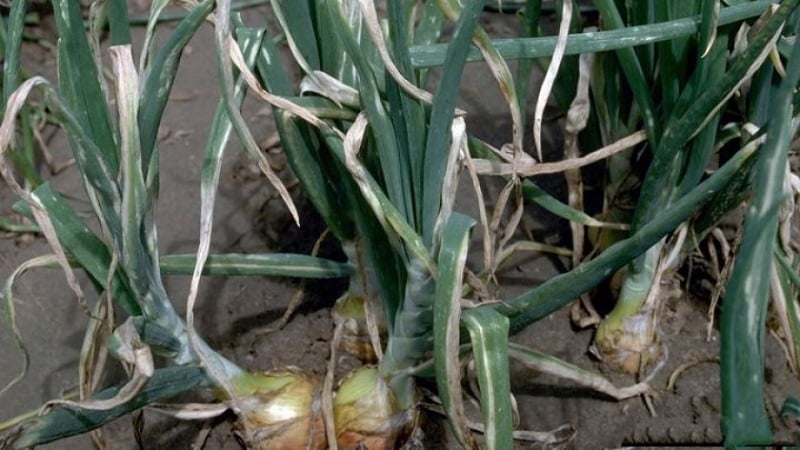
Signs and symptoms
Diseases develop both on the above-ground parts of the plant and inside the bulbs.Fighting them is mandatory, otherwise there is a high risk of losing the harvest.
The development of the disease is indicated the following signs:
- yellowing, fading and deformation of the feather;
- the appearance of stains and mold on onions;
- changes in the structure of leaf and bulb tissues;
- black spots on onions.
Types of diseases
There are two main groups of diseases Luke:
- fungal;
- viral;
- bacterial.
Fungal diseases of feathers
Onion feathers are susceptible to infection:
- peronosporosis;
- Alternaria blight;
- rust.
Downy mildew
Peronosporosis, or downy mildew, - a common fungal disease that affects all onion varieties. In spring, infected seedlings cannot be distinguished from healthy ones. But after 20-30 days the plants begin to wither.
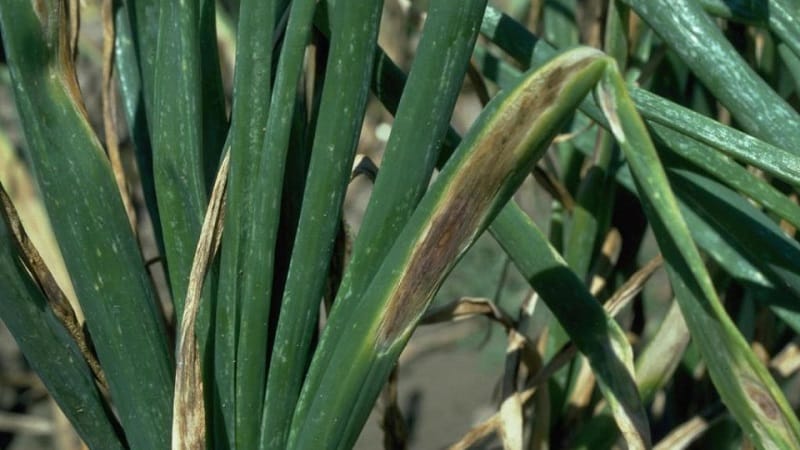
The first signs of infection appear on the tips of feathers. They turn yellow and change shape. Then the leaves become covered with yellow spots. In rainy weather, a gray-violet coating forms. Gradually, the fungus spreads throughout the plant, affecting the bulb.
Carefully. Shading, low placement of beds, cloudy weather lead to the active development of fungus. Densified plantings contribute to the rapid spread of harmful spores.
Disease actively progresses at high humidity air and moderate temperature (+15-20°C). Under unfavorable conditions, the fungus does not die, but only stops development.
The source of infection is poor-quality planting material and violation of crop rotation rules. A seedling infected with a fungus retains its spores until the next sowing season. The pathogen overwinters on seeds and plant debris in the soil.
Alternaria blight
Fungal disease common in all onion growing areas. It is most dangerous in warm, humid climates.It develops quickly, the first symptoms of Alternaria appear within a couple of days after infection.
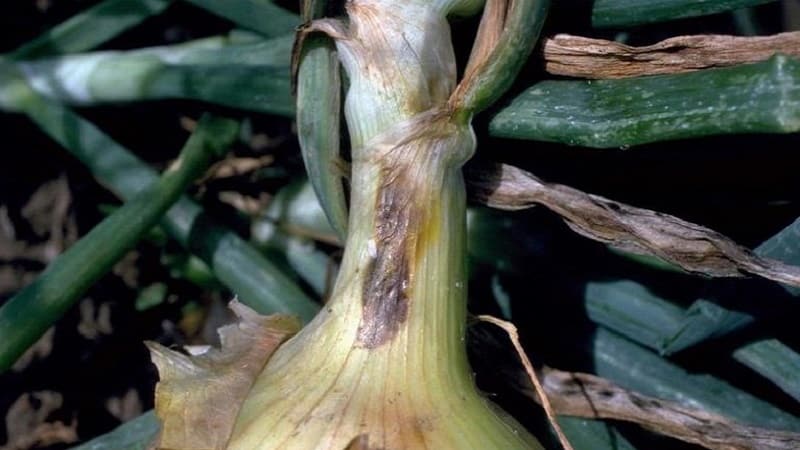
First, watery spots with a white center form on the feathers. Gradually increasing in size, they darken and become brownish-burgundy. The edges of the spots are surrounded by yellow stripes.
Attention. The causative agent of Alternaria often affects weakened, old plants suffering from downy mildew. In this case, the onion feather turns black and dies.
Gradually, the disease also affects the bulbs. The tissues acquire a watery structure, then darken, and a brown coating appears between the scales.
The fungus overwinters in plant debris, on affected bulbs and seeds.. During the growing season, spores are spread by wind.
Rust
The causative agent is the fungus Puccinia porri Wint, which loves a moist, warm environment. The disease is recognized by small orange-yellow swollen spots, which then turn into black dots.
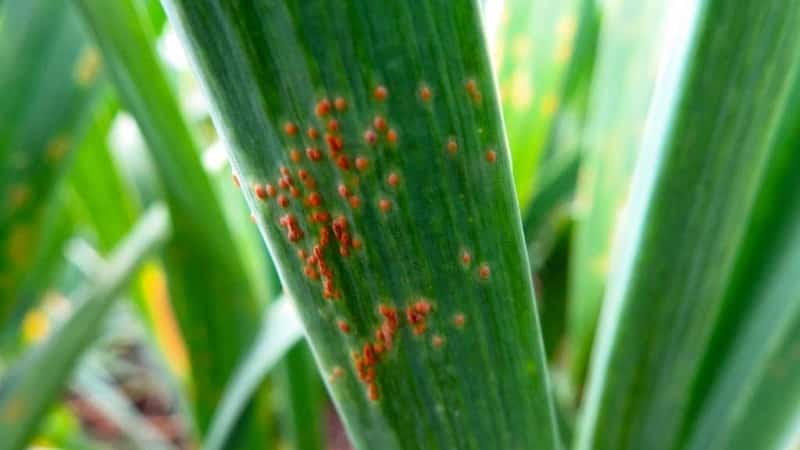
The pathogen migrates from onion beds to currants and other shrubs. Among the reasons for the appearance are early or thick planting, an abundance of weeds and excessive watering.
Need to know. The fungus settles only on wet onion feathers. During periods of prolonged rain, spores germinate quickly.
Fungal diseases of bulbs
Bulbs are affected by the following diseases fungal origin:
- cervical rot;
- fusarium bottom rot;
- green moldy rot;
- aspergillosis.
Cervical rot
The development of the disease is caused by a fungus that develops in rotting plant debris. The disease is recognized by the yellowing of the onion neck. Gradually the entire onion turns yellow to the bottom.
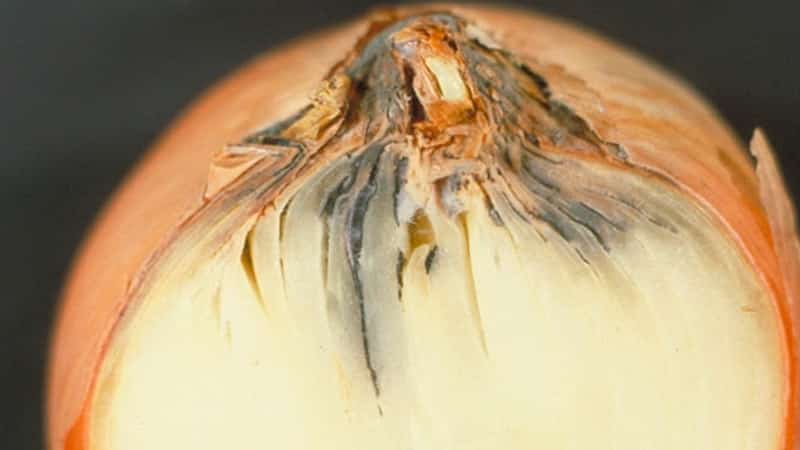
The harvested crop is distinguished by an unpleasant odor and loose scales. When the head is cut, dark areas are visible at the base, on the sides and neck.A photo of neck rot of onions is given below.
Fusarium bottom rot
The causative agent of infection is in the soil. First it affects the tips of the feathers, then leads to their death along the entire length. Gradually it spreads further and provokes rotting of the bulb. The tissues become softer and more watery, and bottom rot appears.
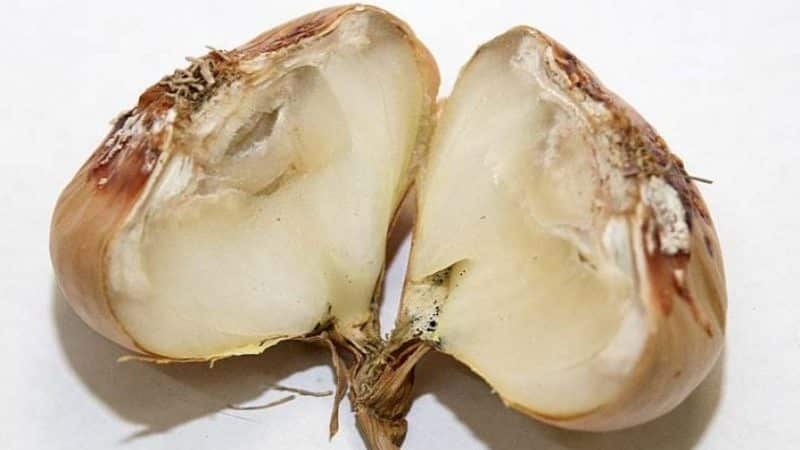
Leads to the occurrence of disease excess moisture in the soil, untimely harvesting, contaminated planting material.
It can be useful:
How to grow onions in a plastic bottle
Green moldy rot
Fungus affects vegetables during storage. It is expressed by drying of the bulb shells and the appearance of green mold on the bottom and side parts. The disease appears after 2-3 months of storage.
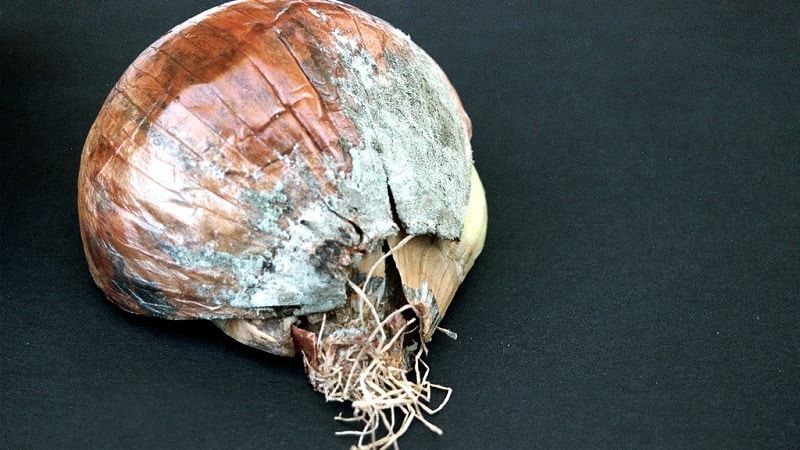
Among the causes of green moldy rot are: mechanical damage during harvesting, elevated temperature (from +3°C) and excess humidity (more than 60%) in the storage.
Aspergillosis
Aspergillosis, or black mold-like rot, - the main problem when storing and transporting onions. During the growing season, it is difficult to notice the symptoms of the disease. It is manifested by discoloration of the neck - this is where the pathogen penetrates the bulb.
Black mushroom spores found under dry scales in the absence of external signs of disease. They acquire a watery texture. After some time, the mycelium of the fungus grows and black spores appear on it.
Important. Aspergillosis is often accompanied by a secondary infection, which causes wet rot of the bulbs.
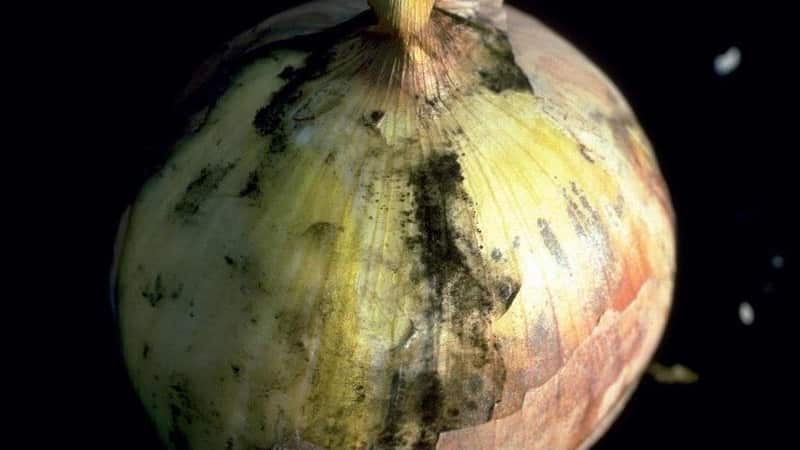
The disease progresses intensively in unripe and undried onions. Elevated storage temperatures and lack of ventilation contribute to the development of the disease. The pathogen persists in affected bulbs and plant debris.
Viral diseases
In addition to fungal diseases, onions are susceptible to viral infections, for example, mosaic and yellow dwarfism.
Mosaic
Green onion mosaic affects both the bulb and the feather. The disease is recognized by light yellow spots and light green longitudinal lines on the stems. The edge of the feather curls and dries out. The development of the bulb slows down or stops altogether.
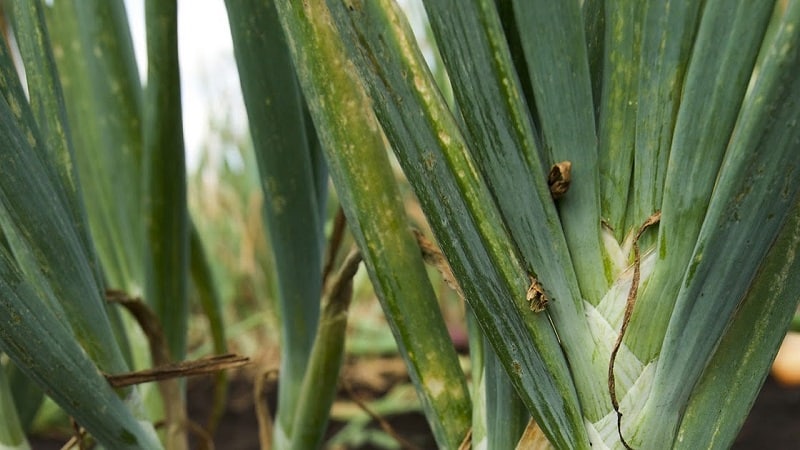
Among the causes of damage are late planting, thickening of plants, lack of control of aphids, the vector of infection.
Read also:
Yellow dwarfism
Yellow dwarfism, or yellow striping, - a viral disease that affects perennial onions and shallots. Leek immune to this virus.
Symptoms of the lesion - yellow stripes on feathers and leaf deformation. The greens curl and lie down, the growth of the bulbs slows down.
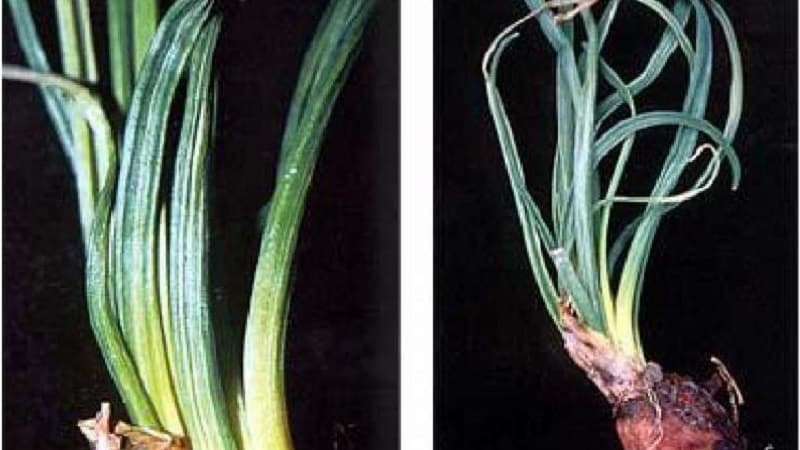
The virus spreads with planting material. It is also transmitted through the parasitic plant dodder and some species of aphids.
Bacterial diseases
Onion plantings are affected by diseases of bacterial origin, in particular bacterial wet rot and black rot.
Wet bacterial rot and black rot
Caused by bacteria that damage already harvested crops. Infection of plants in the soil is possible. The husk becomes moist, the internal tissues of the onion acquire a loose structure, sticky to the touch. When pressed, moisture with an unpleasant odor is released.
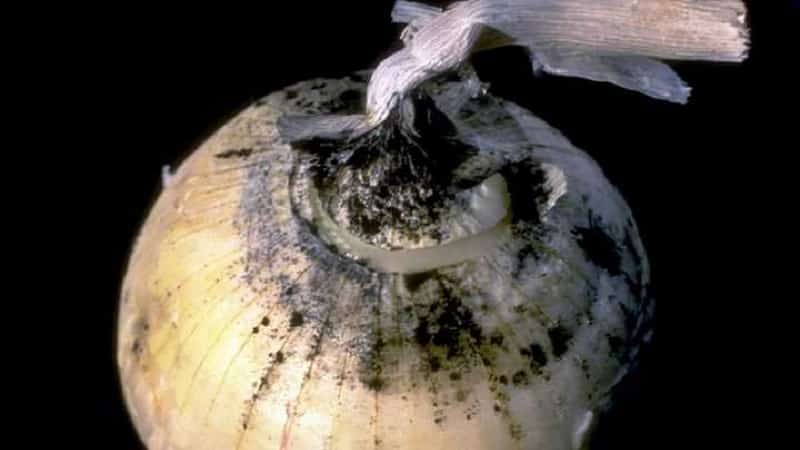
Causes of defeat - increased soil moisture, contaminated soil, violation of storage conditions, crop damage by insect pests.
Fighting methods
The fight against diseases begins when the first signs of damage are detected. Otherwise, there is a risk of complete loss of the crop and the spread of infection to other crops.
Folk
The advantage of traditional methods of control over chemical ones - their safety for humans. Treated plantings are suitable for human consumption.
Among the folk remedies, spraying is distinguished.
The most effective means:
- Wood ash. The solution is prepared at the rate of 50 g per 10 liters of water. Both the above-ground parts of plants and the surface of the earth are treated. Spraying is carried out once a week.
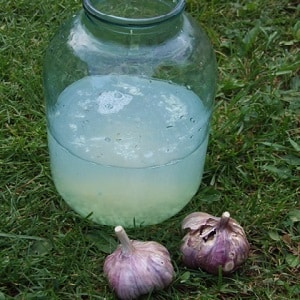 Sour whey. The treatment is effective against fungal infections. Lactic acid bacteria destroy the fungus without harming the onion plantings. To prepare the solution, use whey from any fermented milk product (cottage cheese, curdled milk, kefir). The whey is diluted with water in a ratio of 1:10 and mixed. Spray the plantings once a week.
Sour whey. The treatment is effective against fungal infections. Lactic acid bacteria destroy the fungus without harming the onion plantings. To prepare the solution, use whey from any fermented milk product (cottage cheese, curdled milk, kefir). The whey is diluted with water in a ratio of 1:10 and mixed. Spray the plantings once a week.- Garlic infusion. Effective against rot, rust, scab, leaf spot. The garlic heads are crushed, diluted with water in a 1:1 ratio and placed in a dark, warm place for 10 days. For spraying, use 20 ml of solution per 10 liters of water.
- Plant infusion, for example, horsetail, nettle, wormwood. 1 kg of fresh greens is poured into 10 liters of water. The mixture is infused for two weeks, stirring occasionally. As soon as fermentation stops, the infusion is ready for use. For spraying, it is diluted with water in a ratio of 1:10.
Chemical
If folk remedies do not have the desired effect, then moving on to more effective chemicals.
Attention! Onions grown for harvest are not treated with chemicals.
Of the chemicals used:
- disinfecting the beds before planting with a solution of copper sulfate (25-30 g/10 l of water);
- spraying seedlings with a solution of Bordeaux mixture;
- treatment with a 0.04% solution of zineb or a 0.5% solution of copper oxychloride (once during the period of green growth).
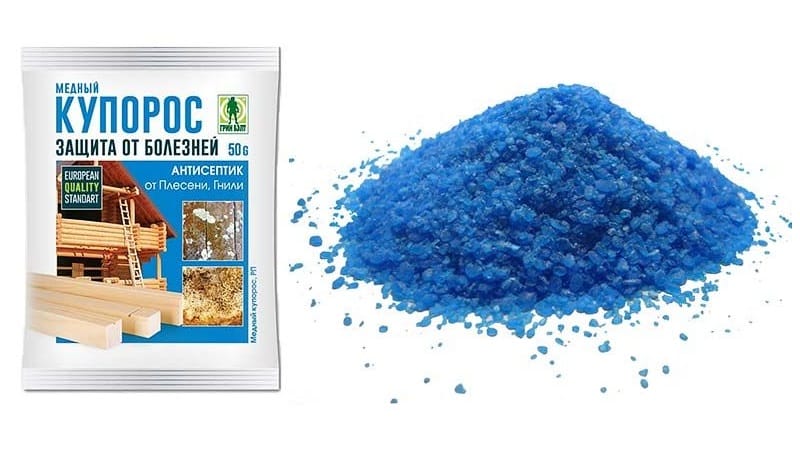
Among biological products, effective use “Gliokladina”, “Fitosporina-M”, “Alirina”, “Gamaira”. These products are used 3-4 times during the growing season. The dosage and method of use are indicated on the packaging.
Prevention measures
Regular use of preventive measures will protect plantings from the development of diseases. They include compliance with planting rules, cultivation technology, harvesting and storage of seed material.
Pre-planting treatment of the site and seeds
Treatment of the site and seed material consists of carrying out the following activities:
- Removing organic residues from the soil surface. This applies to bulbs with roots and above-ground parts of the plant. If there are signs of infection, they are burned.
- Digging the soil in the fall. This helps it freeze thoroughly in winter and reduces the number of pathogens.
- Warming up the seeds before planting at +40°C for 8-24 hours.
- Soaking the seed in a solution of the biological product "Trichodermin".
Other techniques
Effective and preventive measures:
- Compliance with crop rotation rules. Onions are planted in the same place only after 3-4 years. The best predecessors are unrelated plants (cucumbers, pumpkin, cabbage).
- Planting nigella, perennial onions and other varieties separately from each other.
- Periodic inspection of plants for the presence of infected specimens.
- Thinning dense plantings, removing weeds.
- Watering in the morning.
- Compliance with storage conditions - in a cool, dark place.
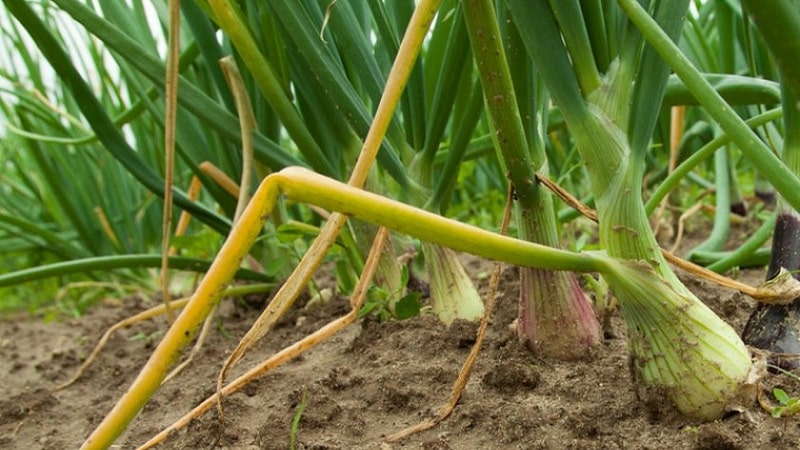
Recommendations and advice from experienced gardeners
Putting into practice the advice of experienced gardeners, you will protect onions from diseases:
- For sowing onions, selected varieties that are resistant to rot are selected.
- The beds are regularly weeded so that the onion rows are well ventilated.
- For sowing, healthy seedlings without the slightest signs of infection are selected.
- Onions are planted on fertile, well-loosened, breathable soils. The crop grows poorly on heavy clay and acidic soils.
- To repel pests that carry infections, use tobacco dust, shag and its infusion, and plant ash.
- Dill and marigolds, planted around the perimeter and in the inter-rows, protect onions from pests and diseases.
- Onions are regularly watered only until the beginning of July, then watering is reduced to a minimum or stopped altogether. Excess moisture provokes the development of fungal diseases and rot.
- Harvest the bulbs in dry weather, avoiding mechanical damage to the heads.
- Before storing, the crop is dried in a dry, well-ventilated, warm place.
- During storage, the bulbs are regularly sorted, removing rotten specimens.
Conclusion
Diseases and treatment of onions, including onions and onions, are far from an idle issue for gardeners. To prevent infections from affecting onion beds, observe crop rotation, water properly, cultivate the area before sowing, and avoid thickening the plantings.
The quality of the seed material is important, since many diseases are transmitted through it.
The material was very poorly chosen.everything is piled up: photo. diseases and treatment. No sequence: Disease, photos, preventive measures and control.
Thank you, we will take note and consider it for the future
The material is clearly copied and not informative (((
Victor, all materials on our portal go through strict anti-plagiarism, copying is excluded. Please clarify what information you were missing in this article?
The article is good and informative (with photos of onion diseases).
I copied the text into my mobile phone to use as a hint in the process of dacha work.
Many thanks to the author (I hope he won’t scold me for copying text into a mobile notepad).